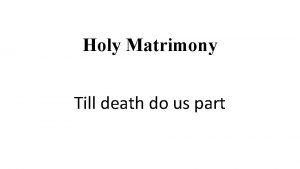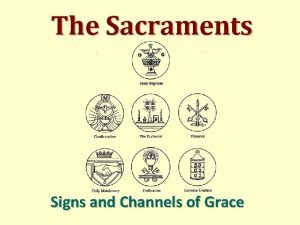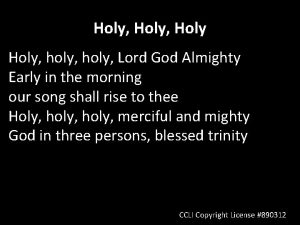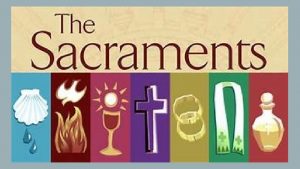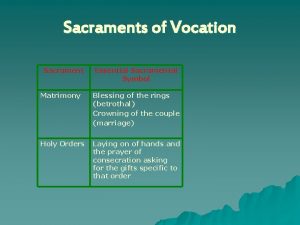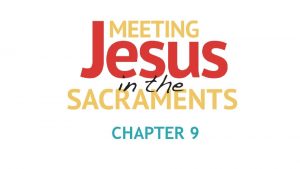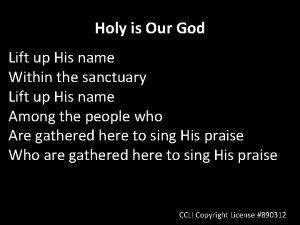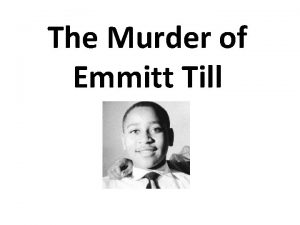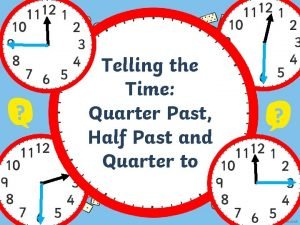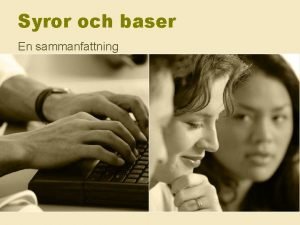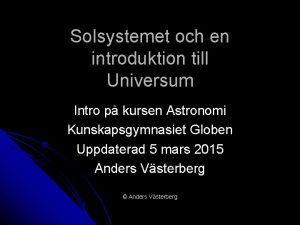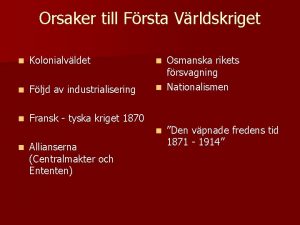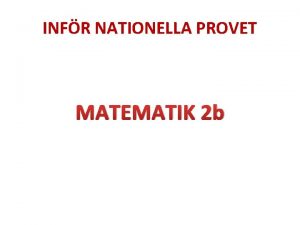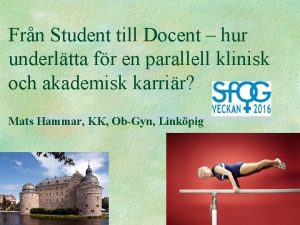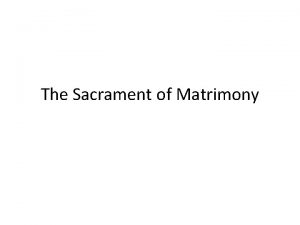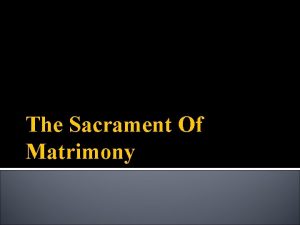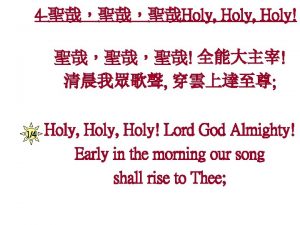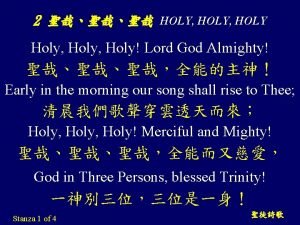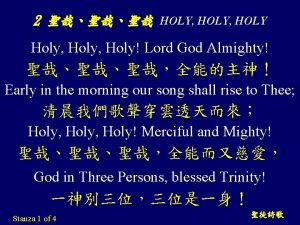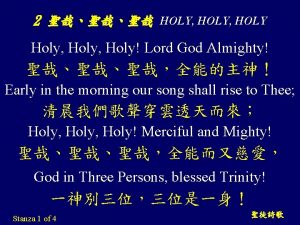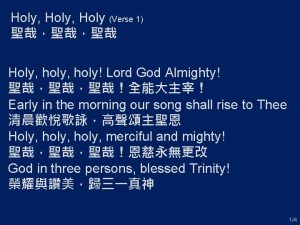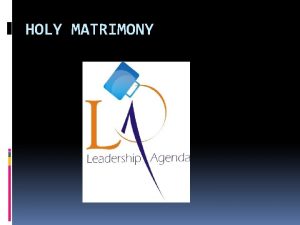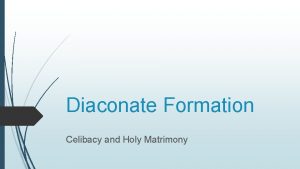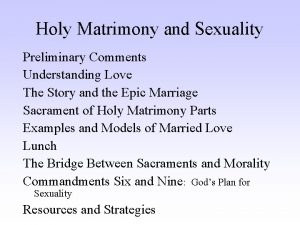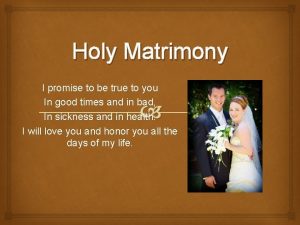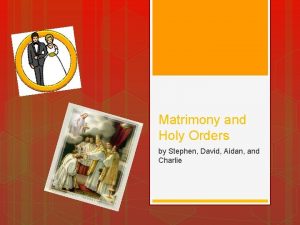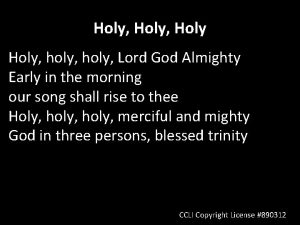Holy Matrimony Till death do us part DEFINITION





































- Slides: 37

Holy Matrimony Till death do us part


DEFINITION AND PURPOSE Def. A covenant between a man and a woman. 1. For community of life and love. 2. For the good of the spouses. 3. For procreation. 4. For the education of the children.

OT: Configurations • Gen 1: 27 -28; 2: 18 -24) • Unity and indissolubility: Gen 2: 24, Hos 1 -3. • Mutual attraction: Gen 2: 24. • Procreation: Gen 1: 28. • Holiness of marriage: Prayer of Tobias (Tb 8: 5 -7). • Reflected the Covenant: Ho 2: 21 -22 • Sacredness: The Decalogue Ex 20: 14 -17

NT: Configurations • The Wedding at Cana (Jn 2: 1 -11) • Unity, (Mt 19: 4 -6). • Divorce, (Mt 19: 9). • Conjugal (I Cor 7).

Theological Development • No Christian rite of marriage in the beginning. • It developed gradually. • St. Ignatius of Antioch: Bishop’s permission needed. • Was intended to prevent Christians from marrying non. Christians. • Tertullian: Marriage was contracted before the church. • Nuptial Mass dates back to the 4 th and 5 th centuries. • Influenced by the Roman Law (consent of the couple was considered the determining factor). • There were clandestine marriages until the council of Trent.

Church fathers’ themes on marriage 1. Christian marriage was a symbol of Christ and his Church (St. John Chrysostom, and St. Ambrose). 2. Marriage confers grace (Tertullian and Origen) 3. Elevation of marriage happened at Cana (Cyril of Alexandria and Maximus of Turin).

Saint Augustine Vs the Manicheans • The Manicheans taught that matter in general and Marriage in particular was evil. • For Augustine, marriage has three goods: 1. Fidelity 2. Children, and 3. A sacrament. • The essential content of marriage is indissolubility. • Also, marriage as a remedy for concupiscence.

• St Thomas Aquinas: Marriage is a sacrament that confers grace. • Trent: Marriage is a sacrament instituted by Christ. • Virginity and celibacy are a higher calling. • Pope Pius XI: The goods of marriage are: offspring, conjugal fidelity, and sacramentality. • Pope Pius XI: Marriage doesn’t confer indelible character, but its efficacy is permanent. • 2 nd Vatican Council: Marriage is a covenant. • St Pope John Paul II: Sexual self-giving finds its true place in marriage.

Marriage as a Sacrament • A marriage between two baptized persons is a sacrament. • Its essential characteristics are unity and indissolubility. Valid Celebration of a Marriage rests on: 1. Legitimacy of Consent. 2. Absence of impediments. 3. Use of the proper form.

• Right: All may marry unless forbidden by law. • Validity: A marriage is presumed valid until proved otherwise. • Merely ratified marriage is not yet consummated. • Ratified and consummated is indissoluble. • Consummation should be done in a human way. • Marriage between a baptized and a non-baptized is consummated, but not ratified.

• The Roman Pontiff can dissolve a marriage that is not yet consummated. • Pope cannot dissolve a ratified and consummated marriage. • Consummation is presumed, if spouses have lived together. • Putative marriage is null in reality, but is believed in good faith to be valid by at least one of the parties.

Matrimonial Consent • The efficient cause of matrimony is the mutual consent of the partners. • The partners are both ministers and recipients of the sacrament. • Should be an act of the will, freely and irrevocably exchanged. • Should be lawfully manifested. • In a marriage by proxy, it should be in writing. • Must be matrimonial. • Is irrevocable.

Conditions for Consent 1. Capacity 2. Knowledge 3. Freedom 4. Content 5. Mutual donation and acceptance

1. Factors of Incapacity/Invalidity 1. Defective Consent • Lack of sufficient use of reason. • Grave lack of discretional judgement concerning essential matrimonial rights and duties. • Inability to assume the essential obligations of matrimony due to psychological issues. • Ignorance of the permanence and procreation. N. B: Ignorance is not presumed after puberty.

2. Ignorance • Of Permanence of marriage. • The requirement for Procreation. • The need for Sexual cooperation. • After puberty it is presumed that the subject has sufficient knowledge to marry unless proved otherwise.

3. Errors • Of the sacramentality of marriage. • Of its Indissolubility and Permanence • Marital Unity. • Error of fact. • Error of person. N. B. Error of quality of person does not invalidate marriage.

• Deceit invalidates marriage. • Condition of the future invalidates marriage. • Being forced to marry invalidates marriage. • Grave fear inflicted from outside, which leaves the person with no other option except marriage.

Impediments • Def: “a legal obstacle that prevents a sacrament from being performed validly and/or licitly. ) • The faithful can notify the PP of any impediment. • Diriment impediment renders a person incapable of validly contracting a marriage. • Impediment can be public or occult. • Some impediments can be dispensed of by the Holy See.

Types of Impediments 1. Age: Men 16, Girls 14 (bishops may establish higher ages). . 2. Impotence: (antecedent and perpetual). (Sterility does not invalidate a marriage) 3. Existing Bond: (exclusivity and indissolubility of bond). 4. Disparity of cult: Catholics cannot validly marry non-baptized persons without a dispensation.

5. Crime: Murdering one’s spouse in order to marry another. 6. Consanguinity: Direct line (ancestors and descendants), and up to including the Fourth degree (brothers and sisters, aunts and uncles and nieces, /nephews, cousins). (in the second degree of the collateral line is not dispensed). 7. Holy Orders: Deacon, priest, and bishop. 8. Perpetual Vow of Chastity 9. Abduction/detention for marriage purposes.

10. Affinity: Spouse and blood relations of the spouse. (marriage is null in the direct line, fatheror mother-in-law with the son- or daughter-inlaw) 11. Public propriety: Putative/concubinage (first degree line). 12. Legal relationship: by adoption (direct line or second degree collateral).

Ministers and Witnesses • The couple are both the ministers, and recipients. • Clergy is the official assistant. • Deacon, if delegated. • Laity can assist, if given permission by the Holy See. • 2 witnesses N. B: If official assistant cannot be approached without grave inconvenience, marriage can be validly and lawfully contracted in the presence of witnesses only.

Place of Celebration 1. For Catholics: Parish Church or Oratory (another church or oratory by permission). 2. Catholic and baptized Non-Catholic: (another church or oratory by permission). 3. Catholic and Unbaptized: Church or another suitable place. N. B: Marriage should be registered in: 1. Register of the names of spouses. 2. Register of Baptism.

Mixed Marriages 1. A Catholic and a baptized non-Catholic Christian, not in full communion with the Catholic Church. (to be authorized by the Bishop). Conditions: 1. Catholic will not defect. 2. All children to be baptized and raised Catholic. 3. Other party to be notified of the promises on time. 4. Both to receive matrimonial instructions.

Benefits 1. Permanent bond. 2. Exclusivity. 3. Strength. 4. Consecration.

Dissolution • A ratified and consummated marriage is only dissolved by death. • Non-consummated marriage can be dissolved by the Pope. • Pauline Privilege: Marriage between two unbaptized persons can be dissolved in favor of the converted/baptized party (1 Cor 7: 1215).

Pauline Privilege: Conditions 1. New marriage is contracted by the baptized party. 2. The unbaptized party departs. 3. Unbaptized party to be asked if she wishes to be baptized too. 4. If she is willing to live peacefully with the baptized without offending the creator.

Polygamy • Baptized polygamous man or woman may choose one wife, husband to retain if he/she does not want the first. • Other wives/husbands should be dismissed. N. B: African challenges.

Petrine Privilege • The pope has the power to dissolve a nonconsummated marriage between: 1. Baptized persons. 2. Baptized person and non-baptized person. 3. Consummated natural marriage (non-sacramental bond) in favor of the faith. E. g. A baptized non-Catholic and a non-baptized person in favor of the non-baptized wanting to marry a Catholic.

Matter • Mutual self-giving. This has two aspects: 1. Transmission of life. 2. Mutual love. NB. Any exclusion of children during the matrimonial contract constitutes a defect in consent and invalidates the marriage.

Form • Mutual acceptance of this self-giving. • Mutual Acceptance must be expressed in words/signs. • I John Chitakure, do take thee. . . • In the Eastern and Orthodoxy Churches the form is the crowning of the spouses.

Form • Should be exchanged publicly. • Marriage can be celebrated secretly. ØBecause of a grave and urgent reason. ØIt should be recorded in the secret register. • Consents freely given. • Assistant and witnesses be present.

The Goods of Matrimony • Def: Was coined by St. Augustine(354 -430) (Bonum/Bona). • He used it to refer to the values and blessings of matrimony. • Defining features, or essential properties of a sacramental marriage. 1. Unity: (Mt 19: 4 -6). (No Polygyny or Polyandry). 2. Indissolubility: (Mt 19: 9). (Sacramental marriage dissolved by death). 3. Fidelity and openness to offspring: Gen 1: 28 (No adultery. No contraception).

Separation: Legitimate causes 1. Adultery Exceptions: ØConsent given by the aggrieved partner. ØGood cause for it. ØCommission of adultery. 2. Grave danger of moral or physical health of spouse and children. e. g. torture, dangerous illness, deviations. NB. The bond remains even after separation: Fidelity, Education of Children.

Convalidation of Marriage: Types • Null marriage becoming valid. 1. Simple Convalidation (A) If a defective consent: Renewal of the consent. (B) An impediment that has ceased/dispensed: Renewal of consent by both spouses. (C) Defective form: Marriage has to be contracted anew.

2. Retroactive Validation • Convalidates a marriage which was null because of: 1. An impediment. 2. A defect in form. NB. A marriage that is null because of a defective consent cannot be remedied in this way.
 Matrimony def
Matrimony def Transubstantiation catholic
Transubstantiation catholic Glory glory oh god almighty
Glory glory oh god almighty Holy holy are you god
Holy holy are you god God be with you till we meet again images
God be with you till we meet again images Matter of matrimony
Matter of matrimony What are the essential sacramental symbols
What are the essential sacramental symbols The sacrament of matrimony chapter 9 crossword
The sacrament of matrimony chapter 9 crossword Tana matrimony portal
Tana matrimony portal Names for the holy spirit
Names for the holy spirit Be holy as i am holy
Be holy as i am holy Lift up his name
Lift up his name Holyhol
Holyhol Deuteronomy 20:8
Deuteronomy 20:8 Part to part ratio definition
Part to part ratio definition What is death
What is death Part part whole addition
Part part whole addition Brainpop ratios
Brainpop ratios Define technical description
Define technical description Parts of front bar
Parts of front bar The part of a shadow surrounding the darkest part
The part of a shadow surrounding the darkest part Minitab adalah
Minitab adalah The murder of emmitt till date
The murder of emmitt till date Quarter past tense
Quarter past tense Supersyror
Supersyror Tillbaka till vintergatan intro
Tillbaka till vintergatan intro Avstånd till plankorsning
Avstånd till plankorsning Förändringsfaktor
Förändringsfaktor 200 to 300 prime numbers
200 to 300 prime numbers Vad är orsaker till första världskriget
Vad är orsaker till första världskriget Matens väg
Matens väg What are the asterisks indicating on the till slip
What are the asterisks indicating on the till slip Rimma meningar
Rimma meningar Food items that can get spoilt in 2-3 days
Food items that can get spoilt in 2-3 days En tråd som är 48 cm lång böjs till en rektangel
En tråd som är 48 cm lång böjs till en rektangel No guilt in life no fear in death
No guilt in life no fear in death Vad är orsaker till första världskriget
Vad är orsaker till första världskriget Från student till docent
Från student till docent
